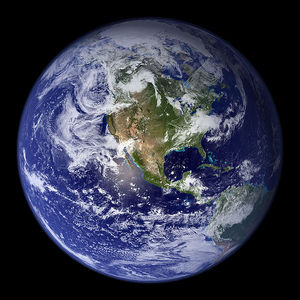In spring 2009, the National Science Foundation and the Earth Science Literacy Initiative released a document entitled Earth Science Literacy Principles containing key concepts about earth science. The document, which can be downloaded free of charge from the Earth Science Literacy Initiative website, outlines nine Big Ideas that encompass the most important concepts of earth science, and provide an excellent overview of what should be included in Earth Science curricula. These principles will be used as a basis for state and national earth science educational standards, as well as a guide for government legislation.
Why is it so important to understand these principles? As Earth’s inhabitants, our very existence depends on air, water, and other natural resources. An understanding of how Earth systems work and interact, how the environment is affected by human activity and how human life in turn depends on the condition of the environment will allow citizens, businesses and policymakers to make informed decisions so that future generations will have an inhabitable planet.
Here is a summary of the nine Big Ideas contained in the Earth Science Literacy document:
1. Earth scientists use repeatable observations and testable ideas to understand and explain our planet. Scientists learn about Earth using many different methods and techniques in both the laboratory and the field, such as radar, sonar, seismic waves, and magnetic fields.
2. Earth is 4.6 billion years old. Scientists use measurements of radioactive decay, analysis of rock and sediment structures and properties, an understanding of geologic processes and observations of other objects in the solar system to determine the age of Earth.
3. Earth is a complex system of interacting rock, water, air, and life. Earth’s systems include the atmosphere, biosphere, geosphere and hydrosphere. Energy and matter cycle through these systems, and they are interconnected in a complex manner.
4. Earth is continuously changing. The geosphere is changed by many factors and processes including plate tectonics, weathering, erosion, and living organisms.
5. Earth is the water planet. Water is necessary for life, and is an important component of Earth’s systems. Less that 3 percent of the surface water is fresh, and less than 1 percent is drinkable.
6. Life evolves on a dynamic Earth and continuously modifies Earth. Evolution is an ongoing process in which life adapts to changing habitats. Extinctions occur when conditions change more quickly than species can adapt. Living organisms cause changes in Earth’s conditions, such as by producing oxygen and fossil fuels.
7. Humans depend on Earth for resources. Natural resources are limited and unevenly distributed. Water, soil and minerals are essential for agriculture and manufacturing, and oil and gas play a part in many components of modern life. Developing renewable energy resources will contribute to sustainability.
8. Natural hazards pose risks to humans. Natural hazards including earthquakes, volcanoes, floods, fires, hurricanes and tsunamis influence societies by driving migration and changing the size of populations. Human activity can increase the probability of some natural disasters such as landslides, floods and fires.
9. Humans significantly alter the Earth. Human activities impact Earth systems by causing climate change, altering land surface and water quality and availability, increasing erosion and causing habitat loss leading to decreased species diversity.
Source:
www.earthscienceliteracy.org
